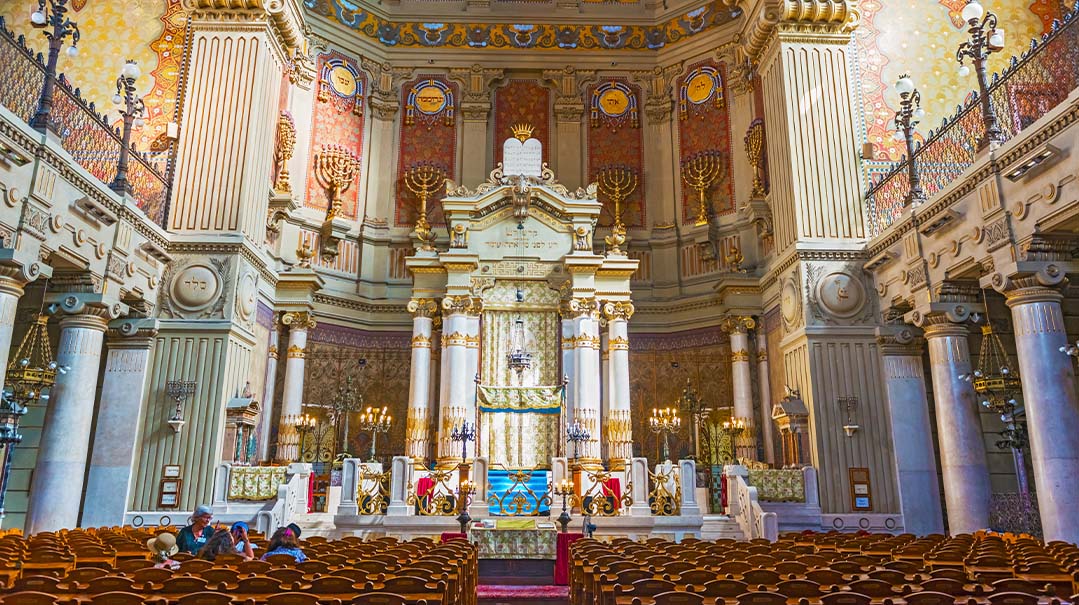When in Rome

Despite economic pain, an ancient Jewish community is holding on

The war against the coronavirus, like Rome, wasn’t built in a day. At the start of the pandemic in early 2020, Italy became an instructive example for the West of just what the coronavirus was. All houses of worship were shut down, according to official reports. The first report of a masked Megillah reading — and not the festive kind —came from Il Tempio Maggiore di Roma, the Great Synagogue of Rome. In Israel, we were able to observe the day fully, while here in Italy it felt more like Yom Kippur.
In the first months of the pandemic, Israeli health experts, as well as senior health officials in New York, both groups of whom were pushing for a blanket closure of shuls, pointed to the “Italian model” of shutting down all places of prayer. But the treasurer of the Great Synagogue of Rome, Yaakov “Manu” Tzarfati, paints a different picture.
I met up with Manu Tzarfati and his son Marco at the gates to what many consider the most magnificent shul in the world. It stands at the entrance to the Jewish ghetto in the city, on the banks of the Tiber. In this city of conical spires, the synagogue’s imposing square aluminum dome stands out on the Roman skyline like a kippah in a crowd. The interior of the building is no less breathtaking than the façade, its spacious high-ceilinged sanctuary decorated with golden menorahs, cornices, reliefs, and paintings.
“We didn’t close the shul,” the treasurer Tzarfati reveals. “We didn’t let tourists in, but they had stopped coming anyway. We members of the kehillah continued davening here every Shabbos. We socially distanced, wore masks, but we didn’t cut ourselves off from our shul, from the beating heart of our community.”
The proud Jewish community was caught up in a crisis on an unprecedented scale. Covid struck Italy before the world had learned how to deal with the virus — either healthwise or in terms of the economy. The tourist trade, Italy’s bread and butter, died overnight. And if this applied to Italy in general, all the more so to Rome, the heart of the nation’s hospitality industry.
Before the outbreak of the pandemic, Tzarfati owned a multi-branch outlet store selling hand embroidered ties with an artistic weave of a unique kind. The two flagship stores — one at the famous Galleria Vittorio Emanuele II in the world fashion capital of Milan, and the second on the Via Del Gambero in Rome, near the illustrious Spanish Steps — were always alive with customers, mostly tourists. I once saw former United States president Bill Clinton emerge from there in the casual wear of an American tourist, with bags full of ties. Clients from all over the world are drawn back here by the magic of the Italian silk fabric, as well as by the Jewish-Italian hospitality of the owner.
I first became acquainted with the son Marco, who gained fluent Hebrew during yearlong study in Jerusalem, when I stepped in to ask for directions to a nearby street. The street wasn’t very close at all, it turned out, but Marco poured us two demitasses of espresso before locking the store and personally guiding me through the alleyways to my destination.
“I’ll never run out of customers,” he explained, perfectly summing up the Italian worldview, “but an opportunity to help a Hebrew-speaking Jew isn’t something I get every day.”
Over the past two years, though, the supply of clients has run dry. Israel’s ambassador to Italy Dror Idan described to me how members of the kehillah who used to send financial support to the Jewish state have now become dependents themselves. Although many members of the community own homes and stores handed down to them through inheritances, so they don’t have monthly mortgages to pay, the disappearance of the tourist trade has nevertheless hit the community hard.
“We closed the store in Milan that we rented from the Galleria,” Marco tells me, “but we’ll never stop creating ties in our unique brand, and nor will we stop showing up at the store.”
“We won’t abandon our profession, and tourism will return,” says Manu in his musical Italian with an overflowing optimism that doesn’t need translation. “And most importantly, we won’t stop going to shul on Shabbos. Our fathers and our fathers’ fathers lived here in the ghetto and continued coming to shul even in the hardest of times. We’ll never relinquish the traditions of Minhag Bnei Romi.”
Hundreds of siddurim in Nusach bnei Romi for the members of the community are arranged on decorated wooden shelves at the side of the Great Synagogue’s vast sanctuary. The text of the nusach is very old indeed, traced back by tradition to captives from the Kingdom of Judea, brought to Rome with the spoils of the Beis Hamikdash as depicted on the Arch of Titus near the Colosseum. The text of the Friday night davening is interwoven from beginning to end with verses dedicated to Shabbos not found in any of the other nuscha’os.
This isn’t a prayer service for those in a hurry. The chazzan, with a high turban perched on his head, begins reading every verse first, pronouncing the words as slowly and deliberately as if he’s counting gold coins. The kahal responds and recites the pesukim with the musicality of Italian. The members of the Rome kehillah, who come to shul dressed in elegant three-piece suits, have class as well as pride.
“The Jewish community in Rome is the oldest in the world,” says Ambassador Idar, whom I first met two years ago at the beginning of the coronavirus outbreak. The learned Idar surprised me with the information that Jewish settlement here predates the Churban. “Jews have lived here since the period described in Maccabees 8, when Judah Maccabeus sent a diplomatic delegation to Rome after cleansing the Beis Hamikdash, in the realization that he couldn’t withstand the Seleucid Empire alone. He was looking around for allies, and sent a request for aid to the Roman Senate in the 2nd century BCE.
“The Jews who have lived in Rome ever since then may have the best claim to continuity with the Roman Empire, because there’s not really much connection between modern Italians and the Roman Empire. Not everyone knows this, but there’s a gap of 700, 800 years between the fall of the Roman Empire and the first stirrings of Italian national identity in the 12th or 13th centuries, before its ultimate realization in the mid-19th century with the reunification of Italy.”
Idar, a graduate of Midrashiyat Noam, a religious high school, was appointed to the position before the outbreak of the coronavirus, at a time when Prime Minister Benjamin Netanyahu still ruled the roost. As a former Yisrael Hayom man — though he wasn’t exactly Bibi’s court trumpeter either — he received the job as something of a sinecure. Before the pandemic, the Italian posting was considered one of the most comfortable positions in the foreign service. Over the past two years it’s become a front-line station.
Last Shabbos, on Shabbos Mevarechim Parshas Misphatim, only dozens davened in the great synagogue, which has room for hundreds. They sat at distances marked out in advance, and the N95 masks didn’t budge from their faces for an instant, even when they raised their voices in song to fill the void. But for now, at least, there are still enough voices to carry the echoes of 2,200 years.
(Originally featured in Mishpacha, Issue 897)
Oops! We could not locate your form.






